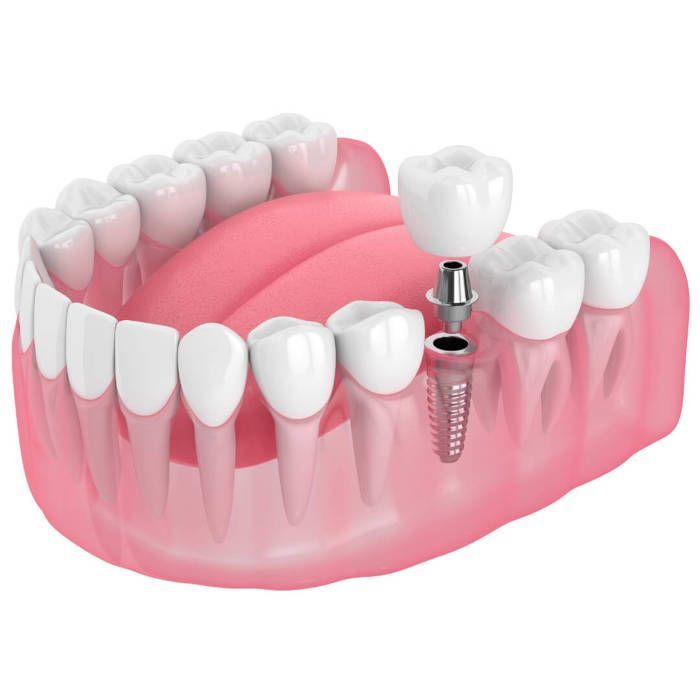Single Tooth Dental Implants: Cost, Procedure, and Benefits Explained
Single tooth dental implants are designed to replace missing teeth with a titanium post and natural-looking crown. They restore normal chewing and enhance your smile. This article covers the costs, procedure, and benefits of getting an implant.
Key Takeaways
- Single tooth dental implants consist of titanium cylinders surgically placed in the jawbone, providing a durable and aesthetically pleasing solution for replacing missing teeth.
- The implant procedure involves several stages, including initial consultation, implant placement, healing, and crown attachment, with careful planning essential for successful outcomes.
- While the cost of
single tooth implants ranges from $3,000 to $4,500, they offer long-term benefits over other methods, such as dental bridges, by preventing bone loss and maintaining oral health.
What Are Single Tooth Dental Implants?

Single tooth dental implants are a modern marvel in the field of dentistry. These implants consist of titanium cylinders that are surgically placed into the jawbone, serving as a sturdy foundation for mounting replacement teeth. Essentially, they replace a missing tooth by inserting an artificial tooth root into the jawbone, which then supports a beautiful, natural-looking crown and can also accommodate artificial teeth. Mouth dental implants provide an effective solution for those seeking to restore their smile.
The main purpose of single tooth implants is to replace missing teeth, providing both aesthetic and functional benefits. They not only enhance your smile but also restore the stability needed for effective chewing. Unlike traditional dentures, which can slip and cause discomfort, single tooth implants feel and function like natural teeth, making them a superior choice for those looking to regain normal biting and chewing capabilities.
One of the standout features of single tooth implants is their ability to mimic the look and feel of natural teeth. The crowns used in these implants are designed to blend seamlessly with your existing teeth, ensuring a natural appearance. The process of getting a single tooth implant involves several stages, including evaluation, implant placement, and crown attachment, each meticulously planned to ensure the best possible outcome.
Why Choose Single Tooth Dental Implants?

Choosing dental implants over other tooth replacement methods comes with a plethora of benefits. Dental implants resemble natural teeth in appearance and functionality, offering seamless aesthetic integration that boosts self-esteem. Imagine smiling confidently without worrying about the gaps left by missing teeth—dental implants make this possible by offering a complete and attractive smile.
Beyond aesthetics, dental implants offer unparalleled functional performance. Unlike removable dentures that can slip and cause discomfort, implants provide solid support, enhancing chewing efficiency and enabling a more varied diet. This stability not only improves your ability to enjoy different foods but also contributes to better overall digestion and health. Moreover, dental implants are crafted to be a lasting solution, potentially enduring a lifetime with proper maintenance. This makes them a valuable long-term investment in your oral health.
Another significant advantage of dental implants is their ability to prevent common issues associated with missing teeth. For instance, they help avert alignment problems, gum disease, and bone loss that can occur when teeth are missing. Unlike traditional bridges, which require the modification of adjacent teeth, dental implants do not compromise the integrity of surrounding teeth, preserving their health and structure.
The Procedure for Single Tooth Dental Implants

The journey to a restored smile with single tooth dental implants involves several precise steps. This comprehensive process ensures that the implant is perfectly integrated into your jawbone and functions seamlessly with your natural teeth.
From the initial consultation and planning to the final placement of the crown, each stage is crucial for achieving the best results.
Initial Consultation and Planning
The first step in the dental implant surgery procedure is an initial consultation where your medical history is reviewed. During this visit, the dentist will conduct various assessments, including X-rays and CT scans, to develop a customized treatment plan tailored to your specific needs. This detailed planning phase ensures that every aspect of the procedure is meticulously mapped out, minimizing risks and maximizing success in implant dentistry.
Collaboration between specialists is often necessary to create the optimal treatment plan. Oral surgeons, prosthodontists, and periodontists may all contribute their expertise to develop a comprehensive approach that addresses all aspects of your dental health. This team effort ensures that you receive the highest standard of care throughout the implant process.
Implant Placement Surgery

The implant placement surgery is the next crucial step. During this procedure, the oral surgeon makes an incision in your gum, drills into the jawbone, and places the metal post that will serve as the implant. Depending on your needs, local anesthesia, sedation, or general anesthesia may be used to ensure comfort during the surgery.
After the surgery, a temporary solution such as a partial denture may be provided to fill the gap while the implant integrates with the bone. Pre-surgery scans, like X-rays and CT scans, are essential to avoid nerve injury and ensure precise placement of the implant.
Healing and Osseointegration
The healing phase, known as osseointegration, is where the magic happens. During this period, the jaw bone grows into and fuses with the surface of the implant, creating a solid base for the crown. This process is crucial for the stability and longevity of the implant and can take several months to complete.
While the bone is bonding with the implant, it’s vital to follow post-operative care instructions to ensure proper healing and prevent complications. Normal side effects such as swelling and tenderness are common but usually resolve within a couple of weeks.
The recovery time after any necessary bone grafts can also vary, typically requiring about three months for healing.
Abutment and Crown Placement
Once the implant has fully integrated with the jawbone, the next step is to place the abutment. This minor surgical procedure involves attaching a connector piece to the implant, which will secure the crown in position. The abutment can be placed during the initial surgery. Alternatively, it may be scheduled for a separate appointment after a period of healing.
After placing the abutment, impressions of your mouth and remaining teeth are taken to create a custom crown that matches your natural teeth. The final crown is then attached to the abutment, completing the process and restoring your smile to its full glory.
Bone Grafting: When Is It Needed?
If your jawbone isn’t thick enough, bone grafting might be required. It is also needed if the jawbone is too soft to adequately support a dental implant. This preliminary procedure aims to create a solid base for the implant by adding new bone material to the jaw. Without sufficient bone, the implant may not be stable, leading to potential complications.
The materials used for bone grafting can vary, including natural bone, synthetic bone, human donor bone, and animal source bone. This procedure can add to the overall cost and duration of the dental implant process but is crucial for ensuring long-term success.
Potential Complications and How to Avoid Them
While dental implants are generally safe, potential complications can arise. These include infection, nerve damage, sinus problems, and implant failure. Infection can be mitigated by following post-operative care instructions and maintaining good oral hygiene.
Nerve damage is a risk during implant surgery, making pre-surgery scans essential for mapping nerve locations. Sinus issues can occur if an upper jaw implant intrudes into the sinus cavity, so precise planning and placement are crucial. Regular dental visits are vital for monitoring the health of your implants and preventing complications.
Cost of Single Tooth Dental Implants
The cost of single tooth dental implants can range from $3,000 to $4,500 per tooth. Several factors influence this cost, including the skill and training required for the procedure and the geographic location of the dental clinic. Costs can vary significantly based on the cost of living in different areas.
Insurance coverage for dental implants is often limited, with less than 10 percent of fees typically covered by insurance carriers. Requesting an initial consultation is the best way to determine the specific costs associated with your dental implant procedure. Despite the initial expense, dental implants are considered a long-term investment in oral health.
Additional costs related to the implant process, such as bone grafting or temporary dentures, can add $1,500 to $2,800 to the total dental implants cost. However, the durability and permanence of dental implants make them a cost-effective solution in the long run.
Comparing Single Tooth Implants to Other Tooth Replacement Methods
When compared to other tooth replacement methods, single tooth implants stand out for their durability and long-term benefits. Unlike dental bridges, which typically need frequent replacement, implants offer a permanent solution that can last a lifetime with proper care. They also do not require the modification of adjacent teeth, preserving the health and structure of your natural teeth.
While dental bridges may be less expensive initially, with costs ranging from $500 to $1,200 excluding crowns, they do not offer the same long-term stability and health benefits as implants. Single tooth implants provide a modern, permanent solution that mimics natural teeth in both appearance and function.
Additionally, implants help prevent bone loss and maintain the integrity of your jawbone, unlike other methods that may not address these issues. This makes them a superior choice for those seeking a long-term, healthy, and aesthetically pleasing tooth replacement solution.
Maintaining Your Single Tooth Implant
Maintaining your single tooth implant is crucial for ensuring its longevity. Brushing twice daily with a soft-bristle brush and gentle toothpaste helps keep the implant clean. Flossing around the abutments is essential to prevent plaque buildup and ensure the health of your gums.
Using antimicrobial mouth rinses can reduce the risk of infections around the implant. It’s also important to avoid smoking, as it can hinder healing and maintenance of the implant. Being cautious with hard and sticky foods protects the implant from potential damage.
Summary
In conclusion, single tooth dental implants offer a permanent, aesthetically pleasing, and functional solution for those with a missing tooth. The process involves several stages, from initial consultation to final crown placement, each meticulously planned to ensure the best possible outcome. When properly cared for, these implants can endure for a lifetime, making them a valuable long-term investment in your oral health.
If you’re considering tooth replacement options, single tooth implants stand out for their durability, health benefits, and natural appearance. Take the first step towards restoring your smile and confidence by exploring the possibility of dental implants.




